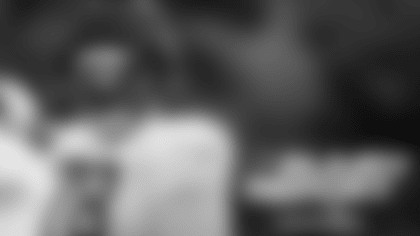Head Trainer Todd Toriscelli (right) and Assistant Trainer Keith Abrams (left) help an injured Buccaneer off the practice field
If you are a Tampa Bay Buccaneers fan, these are the last people you want to see on television. Just the sight of them makes you cringe, maybe even cover your eyes.
Perhaps we should clarify that before we upset the families of Todd Toriscelli, Jim Whalen and Keith Abrams. Those three comprise the Tampa Bay Buccaneers' permanent training staff (there are seasonal additions to handle extra workload) and they certainly don't offend Buc fans with their appearance. It is when they appear on the field during a game that fans can sometimes be apprehensive. If they are spied on television, it will probably be as they tend to an injured player, and that is no fan's favorite moment.
But it is also due to the work of these men that your favorite players make it back onto the field later in the same broadcast, or the next week or month. Injuries are a fact of life in the National Football League; avoiding them, treating them, healing them, minimizing them and reducing their impact is the job of each team's training staffs. The Buccaneers have one of the league's best in Toriscelli and his crew.
That is certainly how Tampa Bay's coaches and personnel staffers feels about the trainers, at least. From the outside, it is a difficult position to compare from team to team; a freak knee injury to a star player, for instance, does not say anything about the competence of the training staff.
Where the acumen of the Bucs' trainers can easily be judged is from within team headquarters, where a calm professionalism rules the training room and its evaluations are considered gospel. According to Toriscelli, not once in his three years with the Bucs has one of his recommendations on a player's status been questioned by the coaching staff.
This level of excellence is reached by a simple formula. "There are two things as a trainer that will make or break you: competence and credibility with the players," said Toriscelli. "If you're not competent, you can last a little while, but you can't fake it in this business. The players will figure it out, and so will the coaches.
"Credibility is something else. If you don't have it, these guys won't trust you. It's very important that the players trust you, so that when you tell them what their injury is and that it's okay to practice or they shouldn't practice, they trust your decision and become compliant with your course of action. And I would say that the competence issue is the easier of the two, because everyone goes to school and we're all certified by the National Athletic Trainers Association. We all learn on the job as we go. But the credibility thing is something that you really have to earn.
Toriscelli came onto the job in 1997, one year after the arrival of Head Coach Tony Dungy and his staff. This is his first stop in the National Football League after stints as the head trainer at Stanford (1995-96), Miami (FL) (1993-94) and Kansas State (1990-92). That means he has had to build that relationship with his players four times in the last decade.
"It takes time," he said. "It's a personal interest, the players knowing that you're doing what you can and looking out for them. Especially in the NFL, where you're talking about guys' careers and their livelihood. They have to know that you're motivated with them to get them out on the field to play and have a good career."
Whalen is new to the job of Director of Rehabilitation, added to fill that post this spring after the departure of Mark Shermansky, who will now handle the training needs of the football program at Texas Tech. Whalen followed a reverse path from Toriscelli, going from Miami in 1994-97 to Kansas State the last few years. The two overlapped for one year (1994) at Miami. Whalen also worked as an assistant trainer for the New England Patriots from 1992-93.
Abrams remains in the post of Assistant Trainer for his fourth season with the Buccaneers. He came to the Bucs after two seasons as a trainer in the Atlanta Braves' minor league system. The Bucs will also employ a full-time intern during the 2000 season (Pat Jernigan from East Tennessee State) and five training camp interns.
All of them will work very, very hard once training camp begins on July 23. That's the unofficial beginning of the season for NFL football staffs, and at that point, 12 to 14-hour days became the rule, not the exception. Days begin around six in the morning, with equipment setup, daily briefings and the first player treatments. They generally end in the evening, with the hour depending on the number of players being tended to. In between are issues big and small, covering a scary range of topics.
"Most physicians specialize," said Toriscelli. "For example, orthopedic surgeons specialize in bone and joint problems. The internist will specialize in internal problems, illnesses. As a trainer, you have a cursory knowledge of everything. Skin disorders, illnesses, joint problems…you have to know about medications, treatments, et cetera…you have to deal with long-term rehabilitation, emergencies on the field. You just have to know a little bit about a whole lot of stuff."
Physicians are also not generally in daily contact with all of their patients. Trainers are a constant presence in the lives of NFL players, and vice versa; all are part of a common pursuit. That means an emotional involvement for all, something trainers have to dampen on game day.
"The main thing for an athletic trainer during a game is, you can't really get into the game too much," said Toriscelli. "You have to keep a level head. If your emotions are going up and down with the flow of the game, that's going to affect you when somebody gets hurt and you have to be out there and be calm. Even though you pull for your team and watch the game, you have to keep in mind what your role is. When that guy does get hurt on the field, you have to go out there and have a clear head and make clear decisions. Your mind has to think in terms of the medical issues and not connect it to the game that's going on around you."
In part, that means making decisions about the severity and type of injury, which also depends on the type of ailment. NFL players are generally eager to return to the field as quickly as possible, but Toriscelli says trainers tends to err to the conservative side.
"It depends on the injury," he elaborated. "For example, somebody might have a muscle pull. With most injuries, there's a chance that it's going to get worse if you keep playing. We will accept that risk with that kind of injury (muscle pull) and the player will too, because these guys are motivated.
"Now, with injuries like concussions or neck trauma, you're ultra-conservative because the potential outcome of that could be devastating. Whereas, if somebody makes a pulled quad a little bit worse, you can overcome that. If someone has a hairline fracture in the neck and you're letting him play, that's incompetence. That's unacceptable.
"I think there's a misconception about he NFL, as far as medical staffs go, that we abuse these guys and put them out there when they shouldn't be out there. Nothing could be further from the truth. No owner of a team would ever want you to do that with one of their players."
What makes the job confounding is when there are numerous decisions of this type to be made all at once. By the middle of an NFL season, the majority of a team's players are nursing some ailment or another, injuries the casual fan never hears about but would be enough to keep someone out of a weekend softball game.
Toriscelli estimates that in a typical November game week, about 30-35 players from a roster of approximately 50 are receiving some sort of daily treatment. There are often several cases a week in which a player would not be able to go on a Monday but is pushing himself to be ready by the following Sunday. That process is helped by the fact that well-conditioned NFL athletes tend to be very fast healers, according to Toriscelli.
Sometimes, the situation can be even worse. In addition to monitoring the health of each individual player (which the plugged-in Toriscelli does with the help of a computer database), a training staff can sometimes get a feel for the condition of the team as a whole. Such an intuition may have played a role in one of the Bucs' biggest wins last year.
"What happened was, we played out in Seattle and the whole team was sick with the flu," said Toriscelli, describing a late-season incident that led to he and his staff being awarded a rare 'game ball' by Head Coach Tony Dungy. "We had a couple of tough games in a row, then we went out to Oakland and just got killed. We came back and had a real hard practice on Wednesday.
"Our team was beat up. I couldn't believe it. We had guys on the floor; there were still lines for the whirlpool at 7:30. It was different. After practice on Wednesday, I sat down with Coach Dungy and said 'We've got problems. Physically, we're beat up and we're headed in the wrong direction, guys are tired, a lot of guys have the flu.' He said, 'What can we do?'"
Knowing that Dungy was an 'old-school' coach who believed firmly in the values of a steady routine, Toriscelli nonetheless recommended a no-pads practice on Thursday, a serious departure from the usual schedule. Dungy reluctantly agreed, and the Bucs followed a lighter Thursday workout with a rousing 29-10 win over Green Bay that guaranteed a playoff spot. It took some prodding for Toriscelli to modestly rehash the story, but NFL Films footage of the postgame locker room clearly shows a group of players appreciative of the work done by the team's training staff.
"That's really what being a trainer is all about, providing that service for the players and trying to gain their trust and confidence," he said. "Not only in the training room, but in the day-to-day stuff, so that they know if something does happen to them on the field, we have the knowledge, equipment and expertise to handle it as well as it can be handled."

























